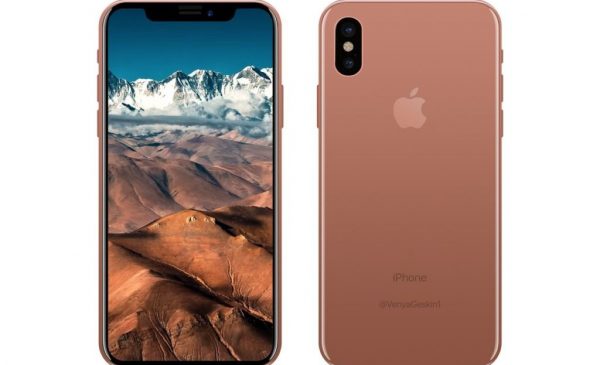Apple has revealed the iPhone X, the phone is pronounced “iPhone 10”, the latest generation of its flagship device. The all-glass device has an edge-to-edge display and no home button. It unlocks using facial recognition software and features wireless charging.
Chief Executive Officer, Tim Cook also launched the iPhone 8 and iPhone 8 Plus, two new phones that have 4.7-inch and 5.5-inch screens to mark the company’s 10 years anniversary. Like the iPhone X, the devices also have an all-glass design and can be charged wirelessly.
In addition to the phones, Apple announced a third generation of its Watch and a 4K Apple TV.
The phone has a 5.8-inch OLED screen, which fills the entire front of the device. Apple has removed the iconic home button to make way for the display, replacing it with facial recognition software called Face ID.
Face ID is used to unlock the phone, authenticate Apple Pay and cutomise the new animoji.
The phone starts at £999 in the UK for the 64GB version, going up to £1,149 for the 256GB model. Coming in space grey and silver, it will be available to pre-order from October 27 and will ship on November 3.
iPhone 8 and iPhone 8 Plus

Apple also announced the iPhone 8 and iPhone 8 Plus, an upgrade to its current offering. The new devices have an all-glass design and can charge wirelessly.
The 4.7-inch and 5.5-inch devices start at £699 and £799 for the 64GB versions. They come with iOS 11 software, which will be available to download from September 19, and an upgraded camera and processor.
Apple Watch 3
The third generation of Apple’s smart-watch is the first that works independently from the iPhone. A cellular version of the device is available from £399 and can make phone calls and browse the web.
Apple also unveiled a 4K version of its set-top Apple TV box at the event.
Why £1,000 isn’t too much to pay for the iPhone X
The price tag of the iPhone X has shocked many Apple followers, but James Titcomb says the cost isn’t that ludicrous. For one, he says:
Think of some other things that may cost roughly the same amount as your phone: a TV, for example, or a holiday. Compared to the TV, you probably get a lot more value out of your phone – which you use for several hours a day rather than a couple in the evening. The memories from holidays might last a lifetime, but as experiences they are fleeting.
Now, imagine how much everything inside your phone would have cost 15 years ago – or more. You have a mobile phone, a sat-nav, a digital camera, a computer, a games console, an iPod, a calendar, a fitness tracker and more. The cost of all of those things combined would be thousands of pounds, not to mention the physical toll of carrying them all around. Because of smartphones, many of them are simple app downloads, costing nothing.
Hands on with ‘the future of the smartphone’
Apple had high expectations to fulfil ahead of the launch of the iPhone X, and one thing’s for certain: it didn’t back away from them. Tim Cook called it the biggest leap forward since the original iPhone, and nothing less than “the future of the smartphone”.
It’s a bold statement, but one Apple had to make. Samsung’s Galaxy S8, released earlier this year, attempted to position the company as the industry’s new flag bearer when it comes to design, and though Apple will insist it doesn’t matter what rivals say, it wasn’t going to take that lying down. So the iPhone X (the X is a “ten”, not an “x”) comes with fighting talk.
What’s new?
The iPhone X is pretty much a complete redesign of the iPhone. It ditches the iconic home button in favour of a screen that takes up the entire front of the phone, in the biggest change to Apple’s handset to date.
Out goes the Touch ID fingerprint scanner, in comes “Face ID”, an advanced form of facial recognition that uses an overhauled front camera system to wake and unlock the phone when you look at it.
A new “super retina” screen claims more detail and bolder colours, and at 5.8 inches is bigger than even the 5.5 inches on iPhone Plus models.
The new front camera system means there’s a notch at the top of the screen, so if you’re watching a video or zooming in on a photo or playing a game in landscape mode, you don’t get the full rectangular picture. I watched a couple of videos and don’t think the notch is really that irritating, but some people might disagree.
Despite the bigger screen, running it to the edges means the iPhone X itself is fairly pocket sized, closer to holding the regular iPhone 7 or 8 than its plus-sized sibling. The casing is glass, rather than the aluminium of recent iPhones, which allows for wireless charging.
Looks-wise, the iPhone X doesn’t initially strike me as being drop dead gorgeous. It’s actually a little utilitarian – a rectangle with curved edges that is simply dominated by the screen. But that’s kind of the point. Apple design chief Sir JonyIve says “the device disappears into the experience”, and that is kind of how it feels.
Bye bye to home button
The most obvious difference in how you actually use the iPhone X is the absence of the home button, which changes a lot of things about how the phone works.
To wake up the phone, you tap the screen or press the lock button on the right, before unlocking it with Face ID (more on that below). To go to the home screen, you swipe up from the bottom, and to open the control centre, you swipe down from the top right (the top left will open Notification Centre as per usual). Siri is activated by holding the lock button, and Apple Pay loads up if you press it twice. To take a screenshot, it’s now a combination of the lock button and the volume up button, and to turn the phone off, it’s the lock button and volume down. So a lot changes when you get rid of the home button.
I was expecting to find it a bit disorientating, especially having to swipe up to go home, but you actually get used to it very quickly. There are some nice new touches in applying these changes too: swiping left and right along the bottom of the screen lets you flick between apps much more quickly.
Face scanning
Since losing the home button also means losing the fingerprint scanner, the iPhone X needed something else to unlock the phone, approve Apple Pay and so on. Thus Face ID, which uses a combination of sensors and cameras on the front of the phone to map and recognise your face. Apple made a big point of showing how secure this is and how reliable it is – it works even in the dark or if you’re wearing glasses or a hat.
Apple’s demo didn’t exactly go smoothly on stage and in the hands on area it seemed to work most of the time, but not every time. This might just be my experience, or it might be one of the things that needs ironing out before the iPhone X goes on sale in November.
There’s a lot more Apple has done with the front camera than just Face ID though. The camera system, which Apple calls TrueDepth, recognises when you’re looking at it, so if you’re reading something the screen will stay on. It means portrait mode, which debuted on the iPhone 7 Plus dual camera last year, now works for selfies, which probably means it will get used a lot more. And the face filters on apps like Snapchat look so much better.
Then, of course, there’s Animoji – Apple’s new custom emojis that follow your facial movements, turning you into a frowning poo or screaming unicorn. Animoji are the sort of thing that only Apple can pull off, and trying it out for the first time is genuinely very good fun.





